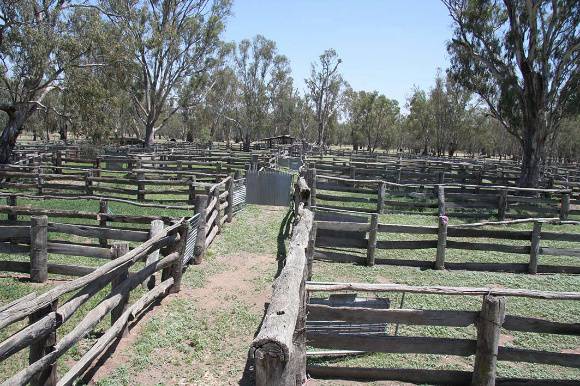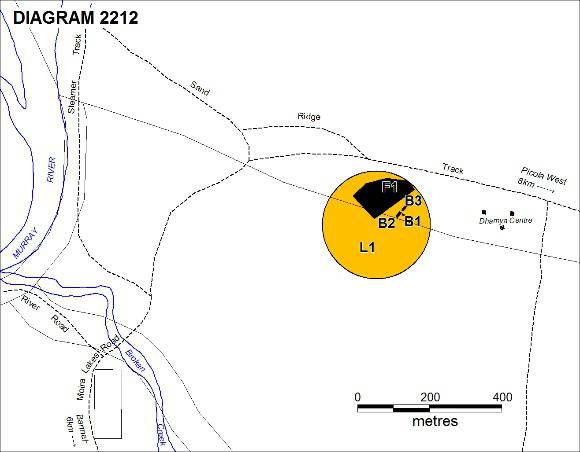| Back to search results » | Back to search page » |
|
BARMAH MUSTER YARDS
LocationBARMAH STATE FOREST, SAND RIDGE TRACK BARMAH, MOIRA SHIRE
File Number10/016070-01LevelRegistered |
|
Statement of Significance
What is significant? The Barmah Muster Yards site has been used continuously from the 1880s as an essential component of cattle grazing activtiy by local farmers in River Red Gum forests along the Murray River. The large timber post-and-rail yards are designed for management of cattle grazed in the surrounding River Red Gum forests. The yards feature a race where stock were identified by owners under the herdsman's supervision, pens named for different localities or the properties of the larger owners for holding of cattle to be removed from the forest, and a 'branding back' pen for cattle to be returned to the forest. The yards have been replaced, remodelled and repaired extensively over the years. Adjacent to the yards is a small complex of buildings which includes a herdsman's hut, built by long-term herdsman Tom Galloway in the early 1950s, a musterers' quarters building brought from a World War II era internment camp c1980, and a kitchen lean-to structure built since the 1980s to serve the expanding annual muster event. To the south are an earth dam and pump-house, and remnants of earlier fences. The large paddock further to the south, known as Goose Swamp, was used to hold the mustered cattle before drafting in the yards. Most of the pastoral runs adjoining the Barmah Forest were selected in the decade following the 'free selection' Act of 1869. The selectors developed a mixed cropping and grazing system. The Land Acts had provided for commons and there were by now many around the state. In 1877 selectors from the Barmah, Nariolta and Picola shires petitioned for a common on an area which included parts of the Barmah and Yielima State Forests and adjoining Timber Reserves. Much of this land was flooded during winter and spring but it provided good grazing in the summer months when feed was short on the farms. The Barmah Common as gazetted in 1878 occupied 17,000 acres including the lower half of Kinnear's Island. As the first managers of the Common, the Echuca Shire council built the first yards. Management was transferred to a committee of local farmers in 1882. The committee employed a herdsman and arranged quarterly musters. From the early 1890s Conservator of Forests George Perrin campaigned for greater Forest Department control of land use in State Forests. As a result the Barmah Common was abolished in 1895. Similarly the grazing lease over the adjacent Yielima State Forest, which had been operated by a syndicate as a common since 1885, was not renewed. The combined areas were subsequently made available for a similar regime of grazing but under Forest Department control, an arrangement described by some at the time as a 'State Common'. A committee of local farmers appointed a herdsman and maintained yards and fences, and the Forester organised two musters a year. From 1911 the Department employed its own herdsmen. During musters up to the 1940s cattle were drafted in succession at Mannions Yards, the Cherry Tree Yards and finally at the Barmah Yards. The grazing areas in the Yielima and Yalca Shires were closed off in 1950 and the Mannions yards fell into disuse. By the mid 1950s the Cherry Tree yards were also abandoned as motor vehicles gave the musterers more mobility, and all of the cattle were drafted at the Barmah Yards. From the 1960s there was a gradual reduction in the number of cattle grazed and in the number of owners using the common, partly because surrounding farms were being amalgamated, and as a result eligibility for grazing was extended to farmers over a wider area. The Barmah Cattlemen's association was formed in 1984 to look after grazing after the Department of Conservation and Lands divested itself of this responsibility. Mustering work was now undertaken on a voluntary basis by local farmers, a number of whom were descendants of the original users of the Commons, and by other volunteers. The muster gradually developed into a wider social event in the district, with increasing numbers of participants and their families and friends camping at the yards over several days each year. How is it significant? The Barmah Muster Yards are of historical and social significance to the State of Victoria Why is it significant? The Barmah Muster Yards site is of historical significance as a rare instance of a physical site with a direct relationship to the operation of a Commons, a form of land use once extensive in Victoria and a vital component of rural life from the Selection Acts through to the early twentieth century. Although the fabric of the yards and related buildings do not date from the Commons era, the location, layout and function of the site have remained substantially the same since the Common was in operation. The Barmah Muster Yards site is of historical significance as a site under continual use from the early 1880s which was the focus of over one hundred and twenty years of cattle grazing activity first on the Barmah Common and subsequently in the Barmah and Yielima State Forests. The Barmah Muster Yards site is of historical significance as a site relating to a regime of mixed land uses practised since the 1870son State Forest lands in the River Red Gum forest of the Murray River. The Barmah Muster Yards are of historical significance for their capacity to demonstrate important aspects of the administration and management of grazing as practiced in the River Red Gum forests of the Murray River. This practice is demonstrated by features of the yards site such as the holding paddock, holding yard, race, herdsman's station, pens allotted to specific localities and landholders, sending back yards and herdsman's hut. The Barmah Muster Yards site is of social significance as a focus for over one hundred and twenty years of continuous participation by farming families from the surrounding district in annual activities relating to grazing of Commons and State Forest.
Group
Farming and Grazing
Category
Yarding/ Loading Facility





